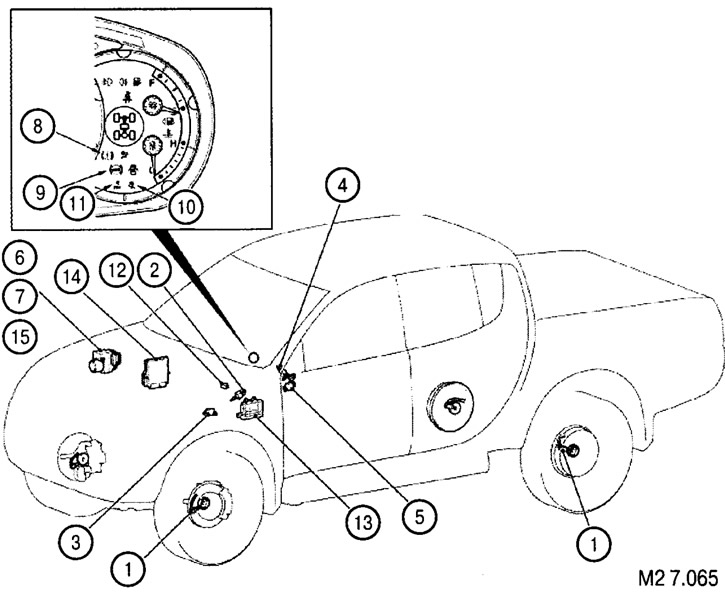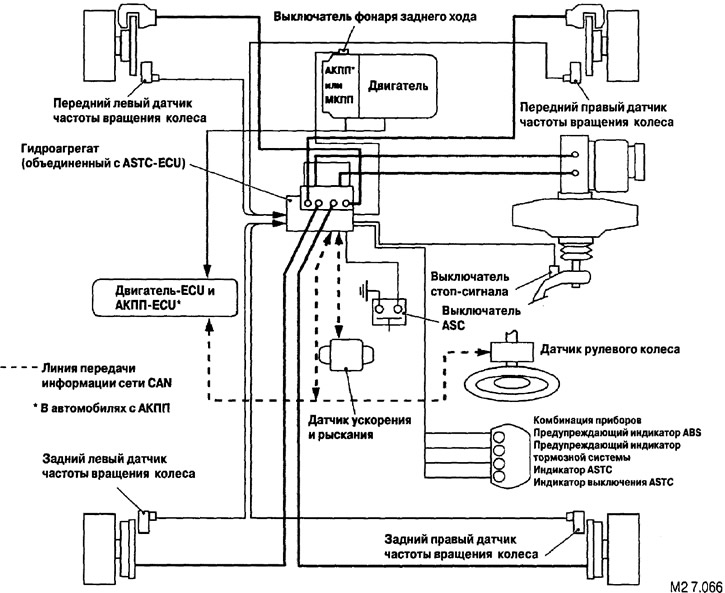General information
Active Stability Control and Stability Control (ASTC) supplied as optional equipment. It combines the functions of an active stability control system (ASC) and active stability control (ATS).
When the ATC system determines the slippage of the drive wheel, it automatically applies the brake of this wheel. On the other hand, ATC reduces engine power and prevents slippage when it determines that the engine torque is too high for the road condition (the angle of inclination is also determined), along which the vehicle is moving.
If the ASC determines that the vehicle is in a dangerous position, it reduces engine power and independently applies the brakes on all four wheels, controlling the behavior of the vehicle and preventing a critical situation.
The system is also equipped with a safe mode function.
To reduce the number of wires and improve the quality and speed of information transfer, communication with the electronic control unit (ECU) implemented through a network of controllers (CAN).
On vehicles with ASC, the ASTC-ECU also controls the anti-lock braking system (ABS).
Placement of system elements

Elements of the stability control system
| № | Detail | Function Description |
| 1 | Wheel speed sensor | Detects wheel speed and reports it to ASTC-ECU |
| 2 | Stoplight switch | Tells the ASTC-ECU when the brake pedal is depressed |
| 3 | Acceleration and yaw sensor | Determines the acceleration in the longitudinal and transverse directions, as well as the yaw of the car and reports to the ASTC-ECU |
| 4 | Steering wheel sensor | Detects steering wheel position and reports to ASTC-ECU |
| 5 | ASC switch | Sends a signal to the ASTC-ECU to enable or disable the active stability control system |
| 6 | Pressure meter | Built into the hydraulic unit; determines the TJ pressure in the master cylinder and informs the ASTC-ECU |
| 7 | Hydro unit | Operates the solenoid valves according to the ASTC-ECU signals, controlling the brake pressure of each wheel |
| 8 | Brake Warning Indicator | Lights up in case of a malfunction in the system |
| 9 | ABS warning indicator | Lights up in case of a malfunction in the system |
| 10 | ASTC indicator | Flashes when the system is running. Lights up in case of a fault |
| 11 | ASTC off indicator | Illuminates when the system is not working or is malfunctioning. Flashes in case of overheating |
| 12 | Diagnostic connector | For diagnostics with a special device |
| 13 | automatic transmission-ECU (only in cars with automatic transmission) | Reports the status of the gearbox to the ASTC-ECU |
| 14 | Engine-ECU | Receives ASTC-ECU signals for engine power control |
| 15 | Block of automatic control of stability and exchange rate stability and electronic control (ASTC-ECU) | Controls actuators based on sensor signals |
| Manages self-diagnosis and safe mode | ||
| Manages diagnostics via the diagnostic socket |
Connection diagram

